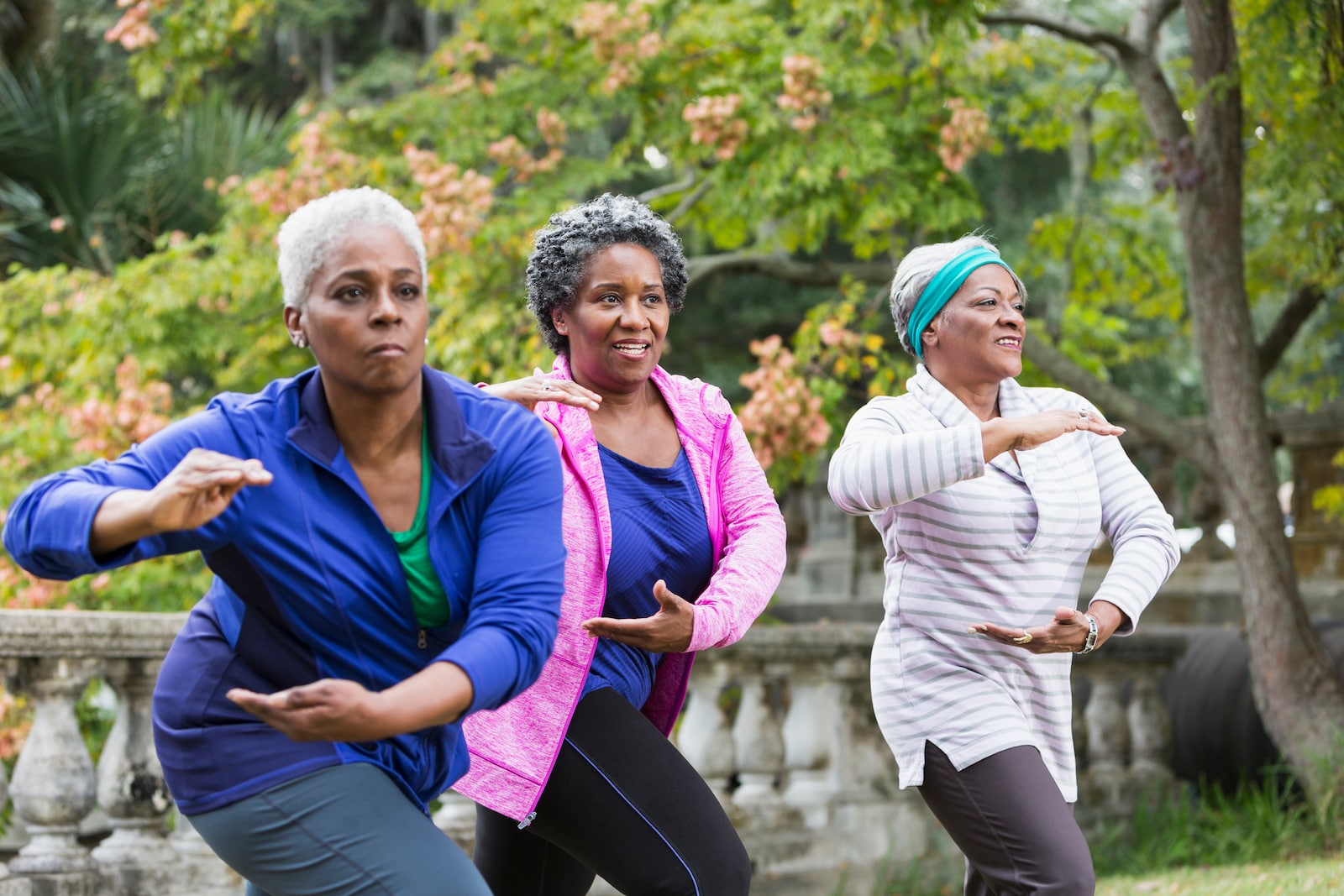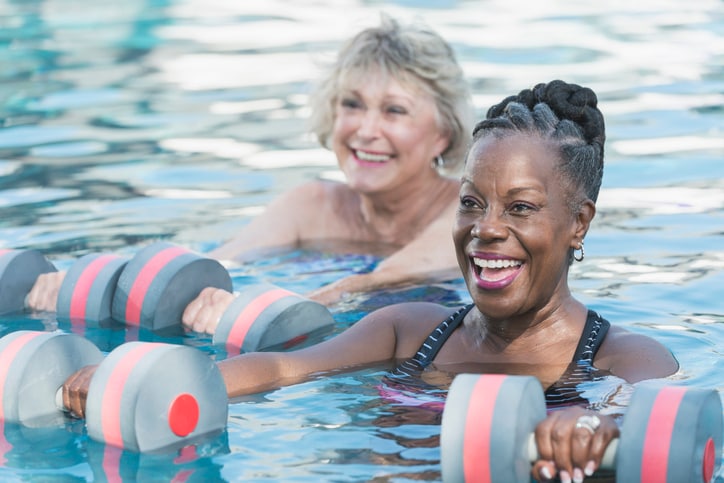One of the best ways to support your senior loved one or client’s well-being is by encouraging them to move, hands down.
“Physical activity is so important for the physical and mental health of older adults,” explains Tina M. Baxter, an advanced practice registered nurse and board-certified gerontological nurse practitioner, noting that exercise can protect against a host of age-related diseases, including cardiovascular disease, stroke, diabetes and certain forms of cancer.
Baxter also explains that exercise can help keep seniors more stable, which can help prevent debilitating (or life-threatening) falls. A systematic review of studies from the International Journal of Behavioral Nutrition and Physical Activity noted that exercise could reduce a senior’s chance of falling by upwards of 23%.
“Physical activity is also invaluable in improving [the mental health of seniors] and improving cognitive function,” notes Baxter. An October 2021 study published in Frontiers of Psychology found that cardiovascular exercise could result in improvements in cognitive abilities and mood in adults over 60.
In other words: Movement is key for older adults. Here, how much physical activity seniors should be getting and the best routines to try for every ability level.
How much should a senior exercise?
The Physical Activity Guidelines for Americans encourages all Americans, seniors included, to perform at least 150 minutes of moderate-intensity aerobic exercise per week. Granted, if you’re caring for a senior who spends the majority of their time in a wheelchair or who you simply can’t see sprinting on a treadmill, there’s some good news: That recommendation probably isn’t set in stone.
Physical activity is critical in maintaining functional health aka walking, eating and doing daily activities.
— Amy Cameron O’Rourke, author of “The Fragile Years”
A JAMA Open Network study noted that moving as little as seven minutes each day was enough to cause a senior’s blood pressure to dip by 10 points over a 20-week period. Physical activity is critical in maintaining functional health — aka walking, eating and doing daily activities, says Amy Cameron O’Rourke, author of “The Fragile Years.”
So, as O’Rourke explains, if the senior you’re caring for can’t engage in a full-blown workout (like many of the ones listed below), that’s perfectly fine. She says that activities like getting the mail, frequently getting up and down, playing cards with friends and gardening count as exercise.
The best exercises for seniors, depending on their ability level
Here, Baxter and Holly Roser, a certified personal trainer, share their favorite exercises for seniors, depending on their level of mobility.
Best exercises for mobile seniors
If the senior you’re caring for is able to move freely sans a walker, wheelchair or cane, the best and most cost-effective exercise solution is also the simplest, says Baxter: walking.
“Many parks have walking programs to help seniors log their steps or miles,” Baxter says, noting that these types of clubs can also promote social connections among seniors — key in curbing loneliness.
Two solid places to search for walking groups for seniors: Meetup.com and Facebook. (Just filter by your location and use keywords like “walking group for seniors” to find a match.)
Alternatively, if the senior you’re caring for is a part of SilverSneakers (the fitness benefit through many Medicare plans), you can browse the network’s FLEX classes, which include walking groups at nearby community centers and parks.
Best exercises for seniors in a wheelchair
For Baxter’s wheelchair-bound clients, she often recommends Tai Chi, which can be used to improve flexibility, she explains. A study from 2016 published in Research in Sports Medicine An International Journal found that seniors who engaged in a 12-week Tai Chi program specifically designed for those in a wheelchair saw improvements in their balance, blood pressure and mental health. Here’s a YouTube video to follow along with to get started:
Roser also has a go-to strength move for wheelchair-bound clients who still have some mobility in their legs to help strengthen the quad, hip, glute and hamstring muscles that can quickly deteriorate when a person isn’t using them frequently: hip adductors.
Here’s how to do it: Wrap a resistance loop band around both quads. You should feel some tension simply sitting. Holding firmly onto the wheelchair handles for support, slowly (and with control) push your knees away from each other as far as is comfortable (so you feel some slight tension, but no pain). Exhale as you push outwards. Pause for one to two counts, then slowly bring the legs back to starting position. That’s one rep. Repeat for three sets of 15 reps.
“This move strengthens the muscles around your hips which becomes increasingly important as you age, specifically supporting your hip joints,” Roser explains.
If the senior you’re caring for has mobility in their arms, don’t hesitate to try an arm-strengthening series. Here’s an upper-body focused routine from YouTube to try:
Best exercises for seniors in a walker
For seniors who primarily use walkers to stay mobile, Baxter says Tai Chi is a winner here, too. Here’s a guided tutorial from YouTube:
She notes that you can also find similar walking groups through Meetup.com, Facebook and SilverSneakers, but for walker-bound seniors primarily.
As for strengthening exercises, Roser recommends calf raises to keep seniors upright and strong. Here’s how to do it: Grasping firmly onto either side of the walker’s handles for support, stand with your feet head-width apart, knees softly bent. Continuing to hold onto the walker, slowly lift your heels off the floor as high as you can. Pause for a single count at the top then return to the ground. That’s one rep. Repeat for 15 reps. (For an extra challenge, lift one foot at a time!)
Best exercises for seniors with a heart condition
If the senior you’re caring for has a heart condition like cardiovascular disease or hypertension, be sure to consult with the senior’s primary care physician before engaging in any exercise program, says Baxter. Chances are, that doctor will have a fairly good idea how much exercise a senior is capable of (and with what modality) that can help guide your assistance.
That being said, mild aerobic exercise can do wonders in improving a senior’s heart health. A few of Baxter’s other favorite heart-healthy exercises: walking and biking.
Just err on the side of caution, says Baxter, when engaging in cardiovascular exercise. “Cardiac patients should avoid any high-intensity exercise,” she says, noting that exercising in hot weather can also exacerbate symptoms.
“Water aerobics and swimming are great low-impact exercises that seniors may engage in to improve their overall health.”
— Tina M. Baxter, gerontological nurse practitioner
Best exercises for seniors with arthritis or chronic pain
For those older adults afflicted with arthritis or another type of chronic pain that might make the exercises listed above feel a bit too intense, one movement modality reigns supreme, says Baxter: swimming.
“Water aerobics and swimming are great low-impact exercises that seniors may engage in to improve their overall health,” she explains.
A recent JAMA Open Network study found that three months of aquatic exercise was more beneficial than physical therapy for adults with chronic lower back pain. Another 2016 study noted that 12 weeks of aquatic aerobics for 50 minutes per session resulted in improved upper limb strength, body fat mass and systolic blood pressure in older adults.
Again, however, Baxter brings back Tai Chi as an all-around exercise superstar that can target pain. A November 2020 study noted that Tai Chi was able to reduce pain in those patients with fibromyalgia, or widespread body pain. Here’s a 13-minute Tai Chi routine from SilverSneakers:
The bottom-line: Being currently active (or even just able-bodied) isn’t a prerequisite to tapping into the trove of health perks associated with exercise for seniors. Anyone, regardless of their physical state, can partake — and reap the benefits.

